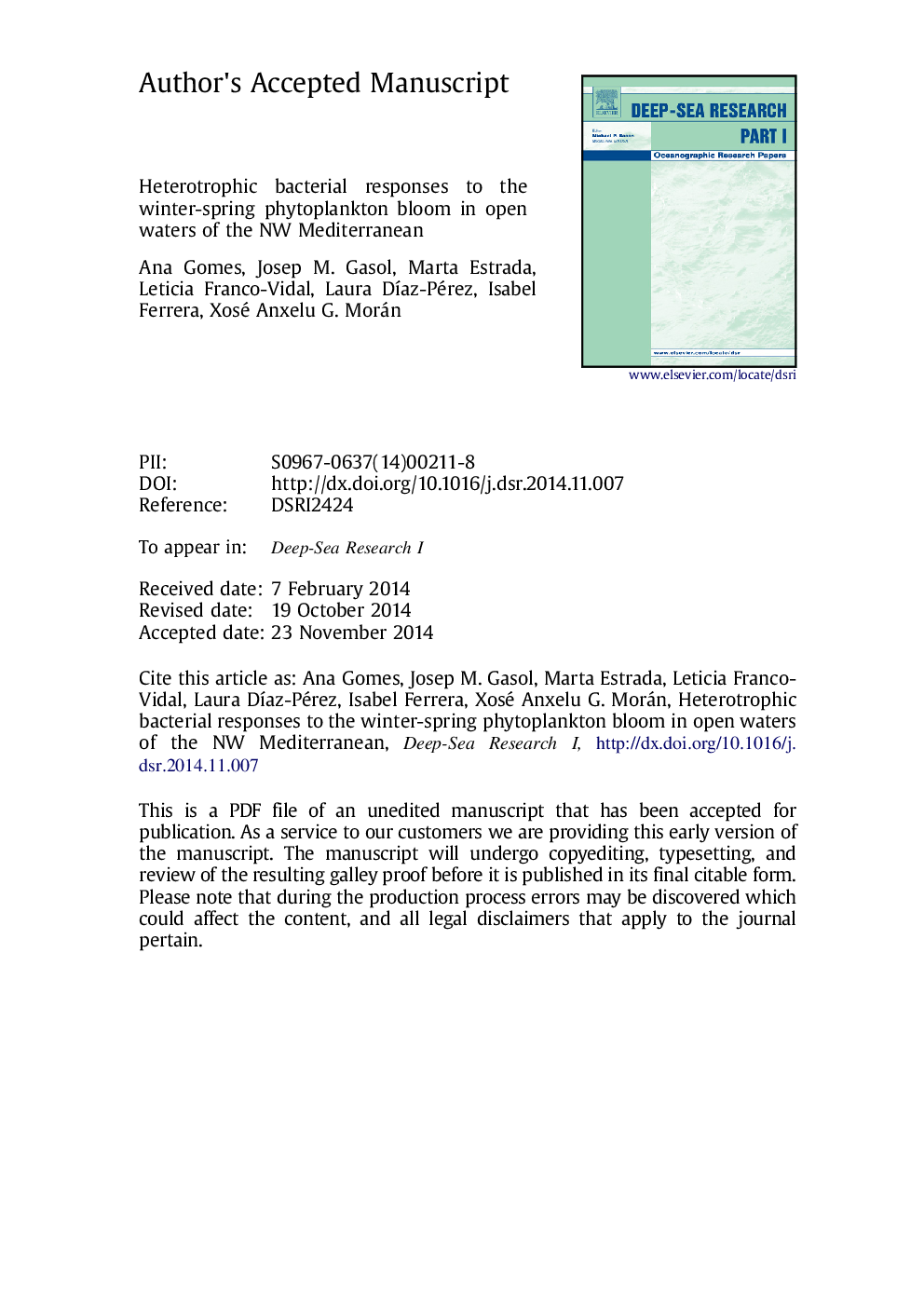| کد مقاله | کد نشریه | سال انتشار | مقاله انگلیسی | نسخه تمام متن |
|---|---|---|---|---|
| 6383592 | 1626334 | 2015 | 43 صفحه PDF | دانلود رایگان |
عنوان انگلیسی مقاله ISI
Heterotrophic bacterial responses to the winter-spring phytoplankton bloom in open waters of the NW Mediterranean
ترجمه فارسی عنوان
پاسخ های باکتریایی هتروتروفیک به شکوفایی فیتوپلانکتون زمستانی و بهار در آب های آزاد دریای مدیترانه
دانلود مقاله + سفارش ترجمه
دانلود مقاله ISI انگلیسی
رایگان برای ایرانیان
کلمات کلیدی
باکتری، فیتوپلانکتون، تولید باکتریایی، محصول اولیه، اتصال فیتوپلانکتون-باکتری-پلانکتون، شکوفه زمستان و زمستان، مدیترانه،
موضوعات مرتبط
مهندسی و علوم پایه
علوم زمین و سیارات
زمین شناسی
چکیده انگلیسی
The response of planktonic heterotrophic prokaryotes to the NW Mediterranean winter-spring offshore phytoplankton bloom was assessed in 3 cruises conducted in March, April-May and September 2009. Bulk measurements of phytoplankton and bacterioplankton biomass and production were complemented with an insight into bacterial physiological structure by single-cell analysis of nucleic acid content [low (LNA) vs. high (HNA)] and membrane integrity (“Live” vs. “Dead” cells). Bacterial production empirical conversion factors (0.82±0.25 SE kg C mol leucineâ1) were almost always well below the theoretical value. Major differences in most microbial variables were found among the 3 periods, which varied from extremely high phytoplankton biomass and production during the bloom in March (>1 g C mâ2 dâ1 primary production) to typically oligotrophic conditions during September stratification (<200 mg C mâ2 dâ1). In both these periods bacterial production was ~30 mg C mâ2 dâ1 while very large bacterial production (mean 228, with some stations exceeding 500 mg C mâ2 dâ1) but low biomass was observed during the April-May post-bloom phase. The contribution of HNA (30-67%) and “Live” cells (47-97%) were temporally opposite in the study periods, with maxima in March and September, respectively. Different relationships were found between physiological structure and bottom-up variables, with HNA bacteria apparently more responsive to phytoplankton only during the bloom, coinciding with larger average cell sizes of LNA bacteria. Moderate phytoplankton-bacterioplankton coupling of biomass and activity was only observed in the bloom and post-bloom phases, while relationships between both compartments were not significant under stratification. With all data pooled, bacteria were only weakly bottom-up controlled. Our analyses show that the biomass and production of planktonic algae and bacteria followed opposite paths in the transition from bloom to oligotrophic conditions.
ناشر
Database: Elsevier - ScienceDirect (ساینس دایرکت)
Journal: Deep Sea Research Part I: Oceanographic Research Papers - Volume 96, February 2015, Pages 59-68
Journal: Deep Sea Research Part I: Oceanographic Research Papers - Volume 96, February 2015, Pages 59-68
نویسندگان
Ana Gomes, Josep M. Gasol, Marta Estrada, Leticia Franco-Vidal, Laura DÃaz-Pérez, Isabel Ferrera, Xosé Anxelu G. Morán,
